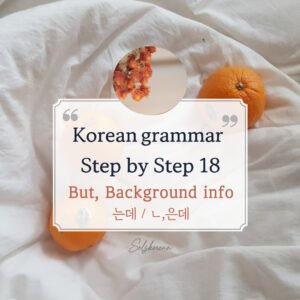Mastering the Korean Alphabet: Easy and quick Memorization Techniques #2
Welcome to the second part of mastering the Korean alphabet!
This section will be relatively brief, focusing on practicing how to read Korean words based on what we’ve learned so far.
First, we’ll briefly review the pronunciation rules when consonants appear as final consonants.
Then, we’ll practice reading Korean together!
Batchim (final consonant) rules / pronunciation

When consonants appear as final consonants, some of them change their pronunciation.
We will mainly focus on the group ‘ㅅ, ㅆ, ㅈ, ㅊ, ㅌ, ㅎ,’ which all sound like ‘ T ‘ when they are final consonants.
Additionally, the consonant ‘ㅇ,’ which is silent when it appears at the beginning of a syllable,
has an ‘ng‘ sound as a final consonant, similar to the endings in ‘shopping‘ or ‘cooking.’
Let’s practice how they sound together!
To make the sound of “나” the process is -> ㄴ + ㅏ = ㄴ (n) + ㅏ (ah) = 나 (nah)
How about 난?
There’s another consonant, so we have to combine ㄴ (n) + ㅏ (ah) + ㄴ (n) again. It becomes 난 (nan). Easy, right?
Now let’s look at this one: 낭. When there’s ㅇ as a final consonant, we add the ng sound.
It will be ㄴ (n) + ㅏ (ah) + ㅇ (ng) = 낭 (nang).
How about with ㅅ, like 낫?
It should be ㄴ (n) + ㅏ (ah) + ㅅ (t) = 낫 (nat). Let’s listen to them!

And be careful! For one syllable, you have to pronounce it as one unit altogether.
In the case of ‘낫,’ where there’s a consonant + vowel + consonant,
it’s considered one set, and you should pronounce each sound together.
Let’s practice this more with different words:
있 = ㅇ(silent) + ㅣ (ee) + ㅆ (t)
었 = ㅇ (silent) + ㅓ (eo) + ㅆ (t)
읗 = ㅇ(silent) + ㅡ (euu) + ㅎ (t)
곧(soon)=ㄱ(G, gun) + ㅗ(oh) + ㄷ(t)
밭(field)= ㅂ(B, bucket)+ㅏ(a) + ㅌ(t)
못(can’t)=ㅁ(M, mouth)+ㅗ(oh)+ ㅅ(t)
응(yes) = ㅇ(silent) + ㅡ (euu) + ㅇ (ng)
빵(bread)=ㅃ(Strong B) +ㅏ(a) + ㅇ(ng)
강(river) = ㄱ(G, gun) + ㅏ (a) + ㅇ (ng)
넹(yes) = ㄴ(N, nose) + ㅔ (ae) + ㅇ (ng)
Let’s try these words together!

ㅂ (bucket, B) + ㅏ (ah) + ㅂ(B ) = 밥(BaB)

ㅂ( B, bucket) + ㅗ (oh) + ㄹ( L) = 볼( Bol )
ㅍ (P, pillar) + ㅔ (ae) + ㄴ(n) = 펜 ( Pen )

ㅇ(silent) + ㅗ (oh) + ㅅ(t) = 옷( Ot )

ㅈ(J, Jeans) + ㅣ (ee) + ㅂ(b) = 집(Jeeb)

ㄷ(D, door) + ㅗ (oh) + ㅇ (ng) = 동( Dong )
ㅅ(S, slope) + ㅐ (ae) + o (ng) = 생( Saeng )

ㅅ(S, slope) + ㅣ (ee) + ㄴ (n) = 신( Seen )
ㅂ(B, bucket) + ㅏ (ah) + ㄹ(L) = 발( Bal )

ㄲ ( K, strong) + ㅗ (oh) + ㅊ(t) = 꽃( Kot )
Sometimes you will encounter double final consonants like these:
There are 11 double final consonants(batchim) in total.
ㄳ, ㄺ, ㄵ, ㄶ, ㄼ, ㄽ, ㄾ, ㅀ, ㄻ, ㅄ,ㄿ.
Some double batchim are barely used in everyday language.
So in today’s lesson, we’ll concentrate on the ones that are more commonly used.
These double consonants might seem daunting at first, but there’s no need to worry!
In most cases, you only need to pronounce the first consonant.

ㄵ, ㄶ -> only “ㄴ(n)” / ㄼ, ㅀ -> only “ㄹ(L)” / ㅄ -> only “ㅂ(b)”
For examples,

[안다]

[여덟]

[갑]

[일다]

[업다]
Here are exceptions:

In these cases, we pronounce the second consonant, which is ‘ㅁ’ and ‘ㄱ (k).’

[익다]

[담다]

[닥]
However, there are some rules to remember to pronounce these final consonants:
when the ‘ㅇ‘ consonant is followed by final consonants, the final consonant carries up. And for the double final consonants, you read both consonants. This helps make the pronunciation smoother.
Let’s look at some examples:
- 읽어요 (to read): pronounces as 일거요 (il-geo-yo)
- 먹어요 (to eat) → 머거요 (meo-geo-yo)
- 닮아요 (to resemble) → 달마요 (dal-ma-yo)
- 이것은 (this) → 이거슨(ee-geo- seun)
- 없어요 (there isn’t) → 업서요 (eop-seo-yo)
- 앉아요 (to sit) → 안자요 (an-ja-yo)
- 넓어요 (to be wide) → 널버요(neor-beo-yo)
Here are some advanced pronunciation rules and tips :
Read through this if you want to know deeper about pronunciation exception and rules!
1.
when the batchim (final consonant) ㄷ(d) and ㅌ(t) are followed by the vowel 이,
they are pronounced as ㅈ(j) and ㅊ(ch) respectively.
For instance, ‘굳이’ (necessarily) pronounces as [구지] / ‘같이’ (together) becomes [가치].
Additionally, when ㅇ follows ㅎ in the batchim, the ㅎ is silent.
- ‘좋아’ (like) is pronounced as [조아]
- ‘싫어’ (dislike) is pronounced as [시러]
2.
The consonants [ㄱ, ㄷ, ㅂ] are assimilated to [ㅇ, ㄴ, ㅁ] when they come before [ㅁ, ㄴ].
- 국민(citizen) → [궁민]
- 잡는(grabbing) → [잠는]
- 먹는(eating) → [멍는]
3.
If the consonants ㄱ, ㄷ, ㅂ, ㅈ appear before or after the final consonant ㅎ,
they are pronounced as strong consonants such as ㅋ, ㅌ, ㅍ, ㅊ.
- 입학(enrollment) → 이팍
- 축하 (congratulation) → 추카
Similarly, the consonants ㄶ or ㅀ, they also transform into strong consonants.
- 잃지 않다(Not lose) → 일치 안타
- 많다(to be a lot) → 만타
4.
When the consonant ㅁ is followed by the batchim ㄱ, ㄷ, or ㅂ,
the batchim ㄱ changes to ㅇ, ㄷ changes to ㄴ, and ㅂ changes to ㅁ.
- 박물관 (Museum) → 방물관
- 믿는 (to believe) → 민는
- 감사합니다 (Thank you) → 감사함니다
Additionally, when the consonant ㄹ follows the batchim ㅁ or ㅇ,
ㄹ changes to ㄴ.
- 심리학 (Psychology) → 심니학
- 종류 (Type, kind) → 종뉴
Moreover, if the consonant ㄹ follows the batchim ㄱ or ㅂ, ㄱ changes to ㅇ and ㅂ changes to ㅁ,
and the consonant ㄹ changes to ㄴ.
- 학력 (Educational background) → 항녁
- 합리적 (Rational) → 함니적





